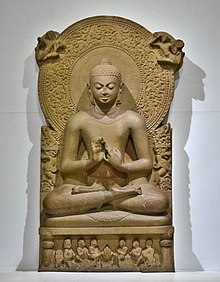

This article needs additional citations for verification. Please help improve this articlebyadding citations to reliable sources. Unsourced material may be challenged and removed.
Find sources: "Buddha in art" – news · newspapers · books · scholar · JSTOR (June 2018) (Learn how and when to remove this message) |

Much Buddhist art uses depictions of the historical Buddha, Gautama Buddha, which are known as Buddharūpa (lit. 'Form of the Awakened One') in Sanskrit and Pali. These may be statues or other images such as paintings. The main figure in an image may be someone else who has obtained Buddhahood, or a boddhisattva, especially in the various traditions of Mahayana Buddhism. Other Buddhas and bodhisattvas in art have become increasingly common over the centuries, perhaps now outnumbering images of the historical Buddha.
In its first centuries Buddhism was largely or entirely aniconic, not showing the person of Buddha except by symbols and relics. This changed, and figures of the Buddha became very common in the art of Gandhara and Gupta art. As forms of esoteric Buddhism developed, other figures from the expanding array of Buddhist sacred persons became more prominent. In Theravada Buddhism this was much less the case, and figures of the historical Buddha remain the most common main images in temples and shrines to the present.
Early images were most often of Buddha standing, but seated meditating postures, essentially the lotus positionofyoga, came to predominate. Often these represent a specific moment in the Buddha's life, which is identified by the Buddha's hand gesture (mudra), or attributes shown. There are also statues of the Reclining Buddha, lying down, usually showing the moment of his death.
Sets of narrative scenes from the life of the Buddha tend to concentrate on standard groupings such as the Eight Great Events or other sets, but may be much larger. Originally common in reliefs, and probably paintings of which few have survived, they have more recently mostly been in painted form. Narrative scenes may show the Buddha in various poses, though they tend to show the Buddha in the same standing, seated or lying positions, with other figures or a mudra indicating what moment is being depicted.
Despite cultural and regional differences in the interpretations of texts about the life of Gautama Buddha, there are some general guidelines to the attributes of a Buddharupa:
The elongated earlobes are vestiges of his life as a prince, when he wore extravagant jewelry. The bump at the top of the head is the ushnisha and represents spirituality, wisdom, and awakening.[1]
Depictions of the Buddha vary widely across cultures.
The image of Buddhas started to emerge from the first century CE in North India, developed in Gandhara and Mathura. The art of Gandhara was influenced by Ancient Greek art, leading to the development of Greco-Buddhist art with anatomically well-proportioned and realistic figure of the Buddha. One of the most influential Buddhist art was Gupta art and the later Amaravati style. From India the depiction of Buddha spread to the rest of Asia. The Buddharupas of India, Sri Lanka, Javanese Sailendra and Cambodian art usually depict a well-proportioned figure, but sometimes he is shown emaciated, in recollection of the Buddha's years of ascetic practices.
Many people may be familiar with the "Happy" or "Laughing" Buddha, a different historical figure, who should not be confused with the images of Gautama Buddha. Budai, a Chinese Buddhist monk also known as Hotei, is depicted as fat and happy, almost always shown smiling or laughing, and is associated with Maitreya, the future Buddha.
A statue or a painting of Buddha always illustrates a mudra or gesture. There are large numbers of these, but a few are the oldest and most common. In Mahayana Buddhism, some of the most common have also become identified with the five transcendental Buddhas, also called "Dhyani Buddhas" or "Pancha Buddhas", further complicating identification of the figure shown. These mudras are as follows:[2]
Images of Buddha showing him reclining, represent his Parinirvana or departure into final nirvana at death.
Other times he is holding various symbolic objects, or making symbolic mudras (gestures).
The clothing also varies with national styles. In East Asia it tends to follow local monastic dress, with the arms covered. In India early depictions, especially from hotter regions, such as art of Mathura, Buddha is often shown with very thin robes or topless, with most of the body uncovered, or appearing so.
An innovation of the Ayutthaya period.
|
| |
|---|---|
| |
|
| Authority control databases: National |
|
|---|